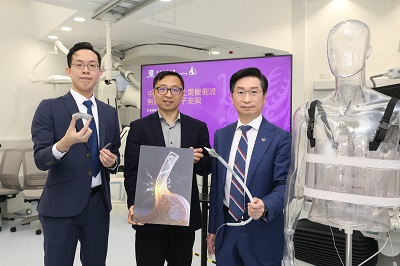|
The gastrointestinal (GI) tract provides noninvasive access to the internal lumen of the body, where numerous health-related information can be obtained, such as biofluids and gastrointestinal motility. Additionally, some chronic gastroesophageal diseases need long-term in situ monitoring and treatment, which requires devices or implants to remain in the gastrointestinal tract. However, operating bioelectronics locally for a sustained period within the GI tract remains a challenge due to repeated contraction, slippery mucosa layer, and confined space inside tubular organs, like esophagus, small bowel, and colon.
A collaborative research team led by Professor Li ZHANG from the Faculty of Engineering, Professor Philip Wai Yan CHIU, and Professor Kai Fung CHAN from the Faculty of Medicine has developed wirelessly powered electronic stents for a new electrical stimulation therapy which could prevent and potentially cure gastric acid reflux. This work overcomes the limitations of powering bioelectronic implants, and provides a transoral delivery and retrieval strategy for in situ diagnosis and treatment in the gastrointestinal tract. This collaborative work, which shows potential for other non-invasive applications, was recently published in the renowned international research journal Science Advances, and highlighted by Nature Reviews Bioengineering.
 CUHK has developed wirelessly powered electronic stents for a new electrical stimulation therapy to prevent and potentially cure gastric acid reflux. (From left) Professor Tony Chan Kai-fung, Research Assistant Professor of the Chow Yuk Ho Technology Centre for Innovative Medicine, CU Medicine; Professor Zhang Li, Professor in the Department of Mechanical and Automation Engineering; and Professor Philip Chiu Wai-yan, Director of the Chow Yuk Ho Technology Centre for Innovative Medicine.
GERD and the limitations of current therapeutic methods
Gastroesophageal reflux disease (GERD) is a very common gastrointestinal (GI) disorder, showing a prevalence of around 8 to 33% worldwide. It is often known as heartburn or acid regurgitation, and characterised by gastric acid flowing back to the esophagus due to weak closure of the lower esophagus sphincter (LES). Gastric acid reflux can cause inflammation and irritation of the esophageal lining. Without effective treatment, it can cause severe complications, including esophageal cancer, a top ten fatal cancer in Hong Kong.
GERD is persistent and hard to cure. Around 8% of patients need life-long medications, which impairs both the physical and mental health of patients. Besides medications, current surgical interventions include Nissen fundoplication and magnetic augmentation, which passively enhance the closure of the lower esophagus sphincter (LES) and require open/laparoscopic surgery. Alternatively, impantable electrical stimulation systems for the LES provide a promising strategy to restore its normal functions without affecting swallowing. However, this requires invasive surgery which poses additional burdens and risks including infection, preventing widespread implementation. With the increasing prevalence of GERD patients worldwide, there is a strong demand for developing a less invasive electrical stimulation system to minimise surgery-induced risks and increase acceptance of electrical stimulations for GERD patients.
Wirelessly powered deformable electronic stent allows non-invasive electrical stimulation of lower esophageal sphincter
To overcome these cahllenges and minimise risks associated with conventional electrical stimulators, the research team has designed a wirelessly powered electronic stent (E-Stent). It consists of a super elastic clinical esophageal stent as the mechanical skeleton, a liquid metal antenna, and an intrinsically stretchable pulse generator. The liquid metal has a low melting temperature of 15.4°and high electrical conductivity. Due to its liquid nature under body temperature, the liquid metal antenna is compliant with deformations in the esophagus. In cooperation with a wearable power transfer system designed by the research team, the elastic antenna can harvest sufficient energy for electrical stimulation therapy through deep tissue even under compression of the esophagus. To further enable technology transfer, the research team has also made use of a laser engrafting machine for batch fabrication of stretchable circuits, which improves design flexibility and boosts fabrication outputs. The intrinsic stretchability and excellent mechanical properties enable the circuit to provide stable biphasic current stimulations under various extreme deformations.
The research team has demonstrated the endoscopy-assisted transoral delivery procedure inside in vivo adult pigs. By combining mesh structures and intrinsically stretchable materials, E-Stent can undergo 150% axial elongation and 50% radial compression for delivery through the narrow esophagus (with an average diameter of 2cm), as proven by X-ray images. The research team has verified in live pig models that continuous electrical stimulations increased the pressure of the lower esophagus sphincter, suggesting a promising alternative to prevent gastric acid relux in a less invasive way.
The research team is now working closely to integrate new functions with E-Stent for other applications in the GI tract and further conduct preclinical studies and clinical evaluation. The team envisions that the development of E-Stent will provide a promising non-invasive platform with high efficiency and safety for various physiological assessments and personalised treatments, and diverse functionalities with high clinical values.
This work is supported by the Research Grants Council (RGC), the HKSAR Innovation and Technology Commission (ITC), the Chow Yuk Ho Technology Centre for Innovative Medicine, and the CUHK T Stone Robotics Institute.  The wirelessly powered electronic stent (E-Stent).
|
